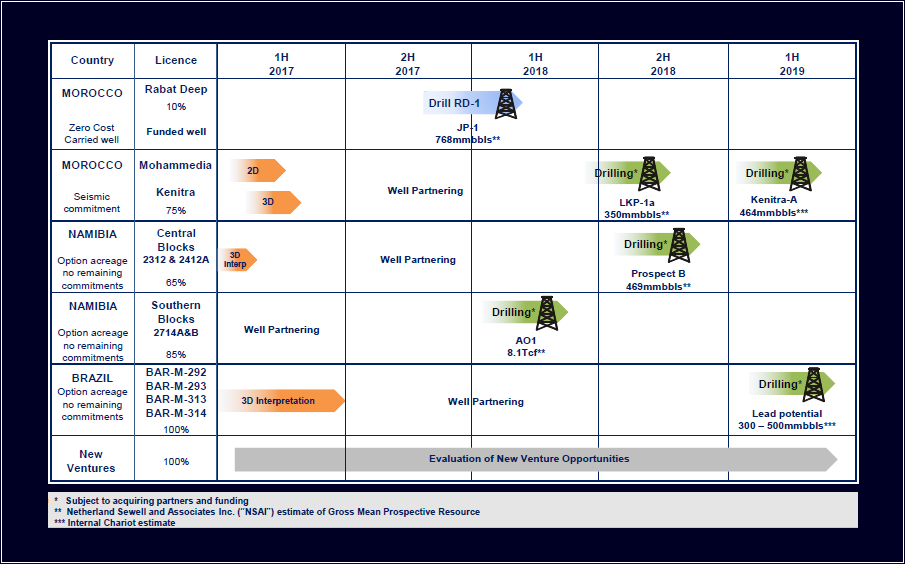Friday, March 03, 2017 8:59:54 AM

Chariot Oil & Gas has plenty of cash, quality partners and lots and lots of seismic data
Chariot Oil & Gas is working up several prospects on both sides of the Atlantic
www.proactiveinvestors.co.uk/companies/news/174222/chariot-oil-gas-has-plenty-of-cash-quality-partners-and-lots-and-lots-of-seismic-data-174222.html
A new seismic programme is just getting underway on the Kenitra and Mohammedia exploration permits off-shore Morocco.
Chariot Oil & Gas Limited (LON:CHAR) currently owns 75% of the license, with the rest held by ONHYM, the state oil company.
How things play out in terms of ownership thereafter depends largely on what sort of results come in. But for an indication as to what could happen in the event of success, investors need look no further than to one of the company’s other exploration blocks in Morocco, Rabat Deep.
Here, work is a little further along.
Major oil companies Woodside and ENI have farmed in, reducing Chariot down to a 10% stake and providing it with a capped carry through the next stage of exploration.
That involves drilling a well costing around US$50 mln, scheduled for drilling early in 2018.
Successful drilling would be transformational for Chariot, even on a mere 10% interest because, as is Chariot’s wont, the target is big.
In this case, the target has been set at a prospective 768 mln barrels, and at around US$50 a barrel on a capped carry, that’s nice money for Chariot.
What’s more, ENI hasn’t come into this project by accident. Rather it was chosen over two other potential partners specifically for its expertise in drilling this type of prospect.
It's helpful of course that chief executive Larry Bottomley knows his way around the oil and gas business, having spent time at Hunt and BP among others. That experience has enabled him to time the seismic markets very well and acquire lots of normally expensive data at very cheap prices.
And the seismic will be used to help Chariot zero in on those big prospects.
“The focus of the company is to get exposure to transformational reserves,” he says.
In this day and age that means off-shore, and often in areas of the world that aren’t yet fully developed as oil and gas provinces.
Thus the Moroccan portfolio, a Namibian portfolio and suite of Brazilian licenses.
All these add up to a geographical focus on the Atlantic Margin, Bottomley’s favoured area of activity. And within that broad parameter he will pick and choose his jurisdictions according both to prospectivity and to the political and fiscal environment pertaining in the relevant sovereign state.
“The company retains its elephant-hunting capacity, but the key is how we go about managing risk,” he says. “When we access basins we do a significant amount of screening work.”
In the initial exploration phases, as at Kenitra, the company ensures that it is the operator.
“That way,” says Bottomley, “we can control our own destiny.”
Then later, when the serious money is needed to sink wells offshore, partners will be brought in.
On this template, Rabat Deep is the most advanced, Namibia is second, as the company is in advanced talks with potential partners there, Brazil is third where seismic data is being interpreted, and Kenitra is fourth.
Having projects at various stages has advantages in terms both of time and cash management, although at the moment there is no real pressure on finances.
At the year-end Chariot had US$25 mln cash in the bank, with US$5 mln of that earmarked for Morocco.
That leaves plenty of room for manoeuvre in terms of funding for further exploration or commitment to other projects.
VHAI - Vocodia Partners with Leading Political Super PACs to Revolutionize Fundraising Efforts • VHAI • Sep 19, 2024 11:48 AM
Dear Cashmere Group Holding Co. AKA Swifty Global Signs Binding Letter of Intent to be Acquired by Signing Day Sports • DRCR • Sep 19, 2024 10:26 AM
HealthLynked Launches Virtual Urgent Care Through Partnership with Lyric Health. • HLYK • Sep 19, 2024 8:00 AM
Element79 Gold Corp. Appoints Kevin Arias as Advisor to the Board of Directors, Strengthening Strategic Leadership • ELMGF • Sep 18, 2024 10:29 AM
Mawson Finland Limited Further Expands the Known Mineralized Zones at Rajapalot: Palokas step-out drills 7 metres @ 9.1 g/t gold & 706 ppm cobalt • MFL • Sep 17, 2024 9:02 AM
PickleJar Announces Integration With OptCulture to Deliver Holistic Fan Experiences at Venue Point of Sale • PKLE • Sep 17, 2024 8:00 AM






